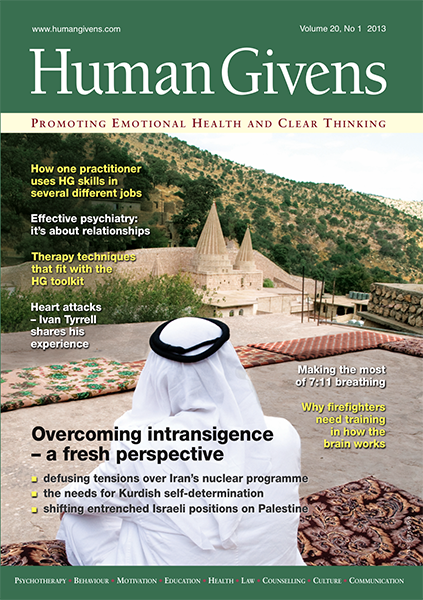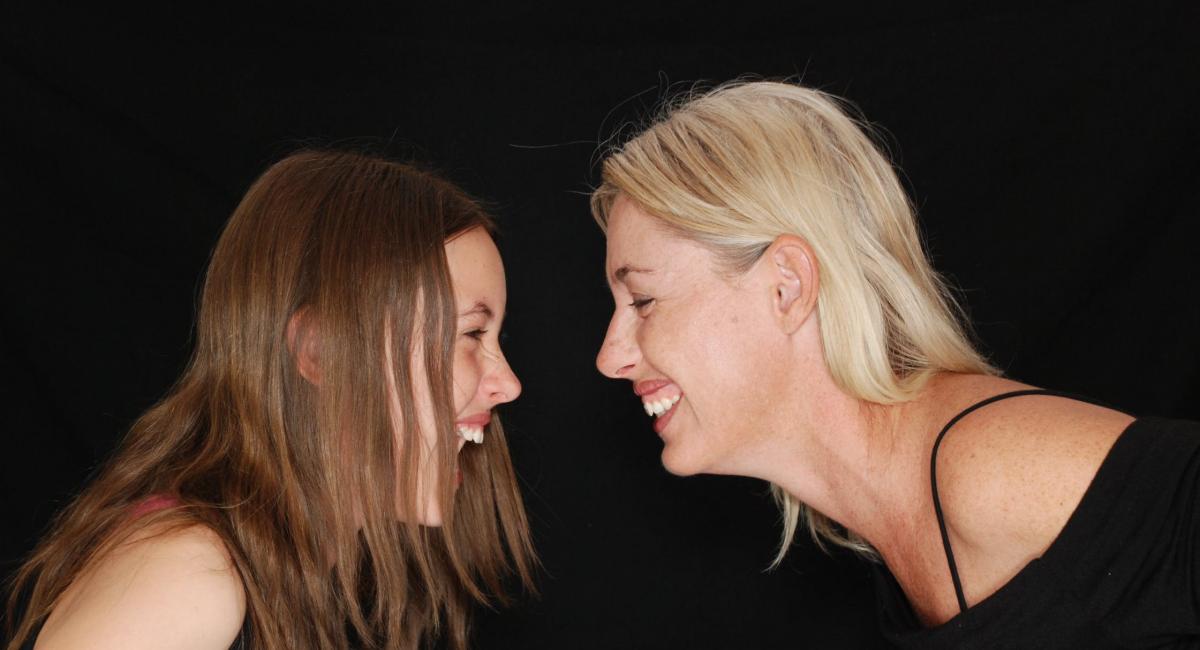Therapy techniques that work
In the first of an occasional series featuring contributions from HG practitioners, Miriam Chachamu shares two simple therapeutic ideas that fit well with the human givens toolkit.
Very many of my clients come with complaints about other people in their lives. Their boss is unappreciative, not even greeting them in the morning; their teenage son is disrespectful, leaving mess all over the living room; their elderly mother is hypercritical of them; their partner is not supportive or not romantic or always forgets important dates…
As they detail their grievances, they usually feel justified and upset, inviting me to adopt their point of view. And that would be quite easy to do, as their story seems so plausible. However, in my experience, going along with our clients’ point of view is not always helpful.1 Our clients’ experience of events is the reflection of the meaning they give to whatever is happening in reality. This meaning is constructed by their brain’s pattern matching process. As we know, pattern matching is often crude, because current events may trigger emotional arousal associated with events from the past that were only broadly similar. Consequently, people may misinterpret situations and react accordingly. An unhelpful, over-emotional response is likely to push the buttons of the person they are interacting with, through the same pattern-matching process. Emotions can escalate and misunderstandings get blown out of proportion. When this happens repeatedly in a relationship with a particular person, clients are likely to feel even more justified in their grievances and soon become entrenched in their positions. They truly believe that the problem is located in the other person entirely and cannot see a solution unless the other person changes.
Working with families and with couples forms a large part of my practice, and I regularly meet people who have very different experiences of the same event. I have to remind myself that I am, in fact, hearing a description of their subjective experience, which they perceive as reality. It is their truth, not the truth. This helped me to realise that, when working with individuals, where I don’t get to hear another version of events, challenging negative perceptions rather than accepting them at face value can be more helpful.1
The pizza technique
I find that the pizza technique is a vivid means of challenging a client’s reality by opening up different possibilities for the meaning of the actions of people in their lives. I use it alongside other human givens therapeutic skills and often reinforce, in guided imagery, any insights gained. The technique is adapted from Martin Seligman’s work with children.2 I modified it first for my work with children and then realised that adult clients benefit from it just as much.
One such client was Sarah. She came to see me because, she said, she was at the end of her tether with her teenage daughter Sophie, who was disrespectful, disorganised, unreliable and uncaring. Sarah was keen to improve her relationship with her daughter and set it as a goal for her first session.
Having identified the ‘problem’ (in this case, Sophie’s behaviour), the next step in the pizza technique is to find a particularly annoying behaviour that encapsulates it. For Sarah, this was Sophie’s habit of leaving the kitchen in a mess, despite Sarah’s endless reminders, pleadings and threats. It had become a big point of friction between the two of them, resulting in many shouting matches and slammed doors.
Establishing the meaning
It did not take long to establish that it was not so much the kitchen mess in itself which upset Sarah but the meaning she ascribed to it. She was angry with Sophie for treating her like a slave, as she put it, and felt guilty for bringing up such a girl. She was also worried about her daughter’s future – how would she cope once she left home, if she couldn’t look after herself properly and take care of things?
At this point, I took a sheet of blank paper which we would use to explore the possible motives behind Sophie’s behaviour. We agreed to head it, “Why does Sophie leave the kitchen in a mess?” I drew a big circle, divided it into eight, like a pizza, and invited Sarah to write a different answer to the question inside each slice.
At first, most of my clients say that they couldn’t possibly find eight reasons. However, once we start we rarely get stuck and, if we do, I offer to contribute some ideas myself. The first explanations clients come up with are almost always negative, and I duly write them inside the pizza slices, agreeing that these may indeed be possible explanations for the undesired behaviour. Once we have a few negative explanations, I encourage clients to think of more forgiving explanations to add into the slices.
Sarah’s initial thoughts were:
- she thinks I am her slave
- she is lazy and spoiled
- she only cares about herself.
I then challenged her to fill in at least five more possibilities, and asked if there was a chance of coming up with a more favourable reason for her daughter’s behaviour. Sarah came up with:
- she doesn’t think cleaning up is important
- she is stressed about her exams
- she wants to get a reaction out of me because I overreact
- she wants to do things her way, as she is rebelling and wanting to be independent
- she simply forgets.
Once we had got going, more and more possibilities came up, and we had to divide one of the slices in two to add: she does put some food back into the fridge but has lower standards of cleanliness than I do.
Shaking up certainty
Once all this is on paper, I ask my clients questions to shake up their previous certainty about the motives they originally attributed to the person they are complaining about. How likely is each one of these explanations to be true? How do they know? Are they absolutely sure? How can they find out? Could several of these possibilities be true at the same time? Which of the explanations are the result of ‘hot’ thoughts – fuelled by their own emotional arousal – and which are ‘cool’? Clients usually see that, often, they do not know which explanation, if any, is true and sometimes they have no way of finding out. They become less certain about their previous negative view. Sometimes it becomes apparent that it would be helpful to discuss the issue with the person involved. Having done the pizza exercise, they are more prepared to approach such a conversation with a desire to understand the other person, rather than to criticise them.
Sarah realised, from her pizza, that Sophie might not be the spoiled brat she had described earlier, and that there could be other explanations for her behaviour. She still wanted her daughter to clear up after herself, but could see the benefit of approaching the topic at a neutral time, when they were both calmer. However, she was worried that any such conversation might deteriorate into mutual blame and shouting, even if she were to approach it from a different understanding. To help her with this, we reinforced her new insights in guided imagery, with Sarah rehearsing being calm and considering her responses.
Sarah reported at the next session that she had indeed been able to have a civilised conversation with her daughter. She didn’t become defensive when Sophie expressed how she had felt when Sarah repeatedly shouted at her, and a new understanding was reached between them.
The balance sheet technique
This technique is designed to explore sticky problems that refuse to go away – the ones that are still there, even though we have diligently followed the RIGAAR™ model (rapport building, information gathering, goal setting, accessing resources, agreeing strategies and rehearsal), as well as, along the way, teaching relaxation exercises, telling stories where appropriate, suggesting reframes and, if necessary, carrying out the rewind detraumatisation technique. Martha was a client of mine who had such an intransigent problem. She was generally happy with her life, with a loving family, a circle of good friends and a satisfying career. But she had one problem which limited both her and her family – a fear of flying.
Martha was so fearful that she sometimes preferred her husband and children to go on holiday without her. However, she had family in America she needed to visit; on those occasions, she would sedate herself and just about make it through the ordeal. There was no clear trigger for her fear, such as a particularly difficult past flight experience. Instead, Martha just remembered flying becoming gradually more difficult for her over the years, to the point where she was leaving longer and longer gaps between her trips to America.
Dave had an equally persistent concern. Three years previously, his wife had left him for another man, taking their two children with her. He still felt consumed with hatred for his wife and her new boyfriend, was fantasising about revenge and had a cynical outlook on life.
 Both of these clients had felt a little better after a couple of appointments. After using the rewind technique to address the previous distressing flights in recent years, Martha was contemplating flying to America again but still felt uncomfortable about it. The rewind technique also helped Dave to entertain thoughts that were less hateful and he did feel calmer, but he still felt extremely strong dislike for his ex and her new partner. Something was keeping both these issues in place.
Both of these clients had felt a little better after a couple of appointments. After using the rewind technique to address the previous distressing flights in recent years, Martha was contemplating flying to America again but still felt uncomfortable about it. The rewind technique also helped Dave to entertain thoughts that were less hateful and he did feel calmer, but he still felt extremely strong dislike for his ex and her new partner. Something was keeping both these issues in place.
Secondary gains
As human givens practitioners, we always give thought to possible secondary gains. We understand that our clients sometimes meet some of their needs through holding onto their problems. As this process is usually subconscious, it can be tricky to suggest it to our clients without losing rapport. Moreover, our guesses may not be accurate, or may reveal only part of the picture. I have found the balance sheet technique a gentle, collaborative way to explore this.
The balance sheet technique, which I successfully used with the two clients above, is a simplified version of a cognitive-behavioural technique that I learned from a colleague some years ago. The idea is to take time with the client to explore the function of the problem in their mental landscape – it took at least 30 minutes to carry out with Martha and Dave. The therapist acts as a facilitator, asking questions and normalising feelings that may surface. I find normalisation is very important here, as sometimes clients are confronted with aspects of their being that are not pleasant to acknowledge.
As in the pizza technique, I write the definition of the problem at the top of a sheet of paper. In Martha’s case this was easy – ‘fear of flying’. For Dave, the issue was not his ex’s current or past behaviour, as these were outside Dave’s control. Instead we needed to address Dave’s thoughts of revenge and feelings of hatred and what they were achieving for him. We settled on ‘hating my ex and her boyfriend’ (as opposed to ‘not caring about them at all’). Once we have the title, I write a sub-column on the left side of the sheet, labelled ‘disadvantages’. I then invite my client to write down all the downsides of having this problem in their life that they can think of.
Dave ended up listing things like ‘wasting time, being miserable, no new relationships, no sex, not enjoying my life, health suffering, being angry’. Martha’s disadvantages column for her fear of flying covered not being able to go on holidays, annoying her family, constantly worrying about future trips, etc. Some clients are so appalled by their list that they are able to drop the issue instantly. When this happens, I don’t go any further. However, in my experience, most clients, like Martha and Dave, need a bit more help.
Human nature
At this point, I explain to clients that I am going to reveal something important about human nature: that, when we have a problem which we seem unable to resolve, it is sometimes because the problem helps us meet some emotional needs. I explain that these needs are understandable and legitimate, and that, once we discover what these needs may be, we can look into meeting them in another way. I then invite the client to think of any psychological advantages the problem may have for them. Another way I sometimes ask this question is “Is there any risk in not having this problem? What could go wrong if you wake up tomorrow morning and the problem is gone?”
When I asked Martha about any advantage to being afraid of flying, her answer surprised us both … It was not having to see her father, who lived in New York. Martha was absolutely shocked by her own discovery. She had a complex relationship with her father, whom she experienced as critical and uncaring. Once she had calmed down, she could see that, by making it difficult for her to get on a plane, her mind was trying to protect her from contact with what it perceived as a threat. The focus of the therapy then shifted to the relationship with her father. The fear of flying responded to the relaxation techniques she had been taught before and completely disappeared.
Dave was very upset when he looked at his list, showing everything he was losing as a result of his anger. When we explored the risks of not being angry with his ex any more, he realised he was holding on to his anger to protect himself from starting a new relationship and facing the risk of getting hurt again. As in Martha’s case, this changed the focus of our session and Dave was gradually able to let go of his anger more and more.
Common gains
The gains I find most common, when doing this exercise with clients, are: getting attention and sympathy from other people in their lives; having a sense of belonging to a group of fellow sufferers; feeling in the right and therefore superior to others; and avoiding perceived risks such as a new relationship or the next step in their career. Sometimes the gain is practical – such as retaining a disability allowance or other financial benefit. Long standing issues often become a part of clients’ identities and they may have no idea who they might ‘become’, should the problem go away. Only once these issues are addressed can the problem be permanently gone.
For particularly sticky issues, I may use both the techniques that I have described here. What makes them powerful is that they are highly visual. We also have something concrete to concentrate on, as we fill in the pie or the chart, and, as this involves the thinking brain, it helps distance the client emotionally. At the end of the session, I usually make a copy for the client to take home.
Miriam Chachamu is a human givens practitioner and supervisor in private practice. She also works part time as a systemic family psychotherapist at a child and adolescent mental health service. She teaches “Understanding and managing children’s behaviour” for Human Givens College and is the author of the book How to Calm a Challenging Child (Foulsham, 2008), which offers an understanding of the world from a child’s perspective and effective communication skills for adults to use to help children become their best.
This article first appeared in Volume 20 - No. 1: 2013 of the 'Human Givens Journal'
 Spread the word – each issue of the Journal is jam-packed with thought-provoking articles, interviews, case histories, news, research findings, book reviews and more. The journal takes no advertising at all, in order to maintain its editorial independence.
Spread the word – each issue of the Journal is jam-packed with thought-provoking articles, interviews, case histories, news, research findings, book reviews and more. The journal takes no advertising at all, in order to maintain its editorial independence.
To survive, however, it needs new readers and subscribers – if you find the articles, case histories and interviews on this website helpful, and would like to support the human givens approach – please take out a subscription or buy a back issue today.
REFERENCES
- Chachamu, M (2009). Dancing out of step. Human Givens, 16, 2, 30–4.
- Seligman, M (1996). The Optimistic Child: A proven program to safeguard children from depression & build lifelong resilience. HarperCollins.
Latest Tweets:
Tweets by humangivensLatest News:
HG practitioner participates in global congress
HG practitioner Felicity Jaffrey, who lives and works in Egypt, received the extraordinary honour of being invited to speak at Egypt’s hugely prestigious Global Congress on Population, Health and Human Development (PHDC24) in Cairo in October.
SCoPEd - latest update
The six SCoPEd partners have published their latest update on the important work currently underway with regards to the SCoPEd framework implementation, governance and impact assessment.
Date posted: 14/02/2024














